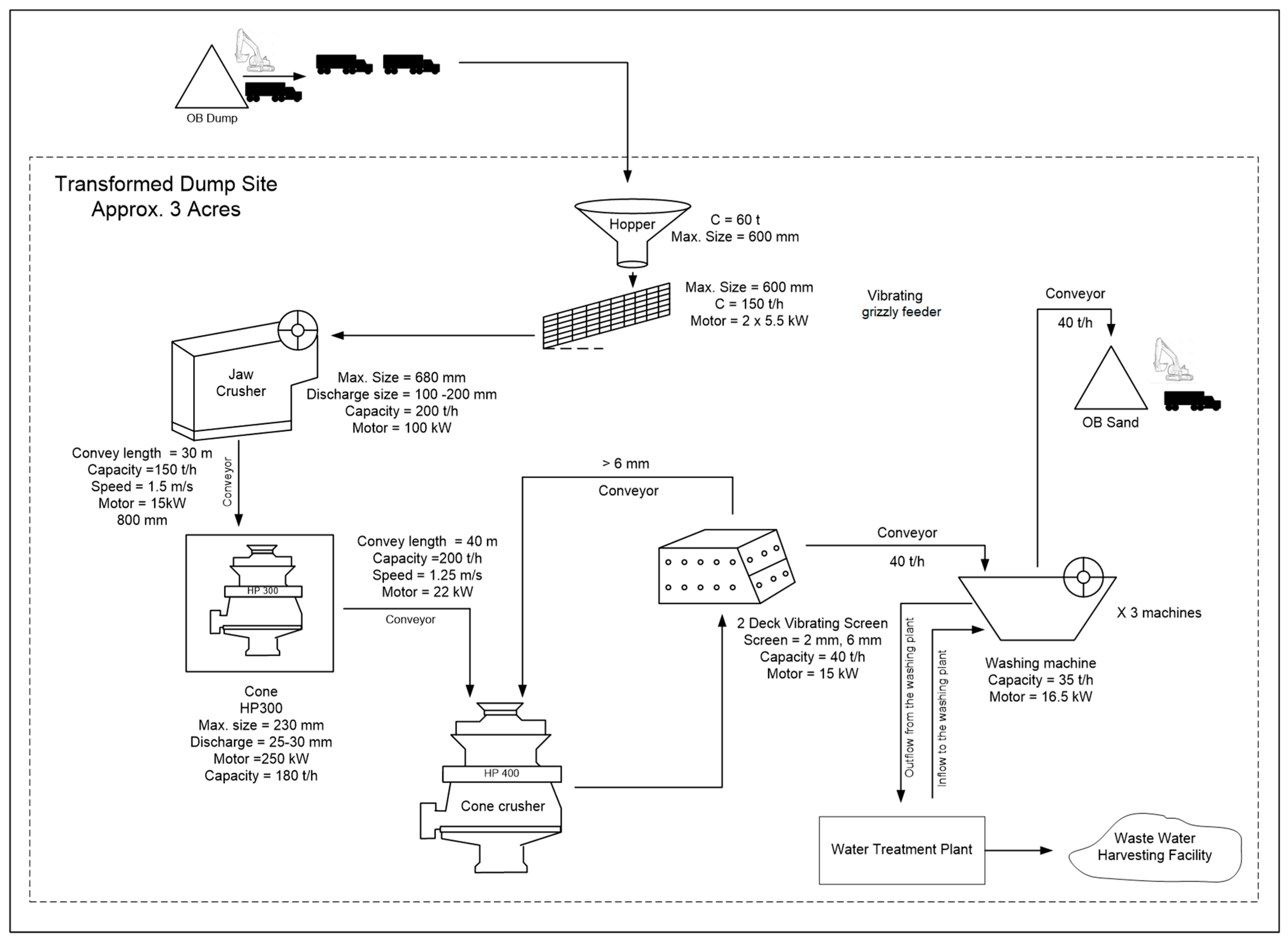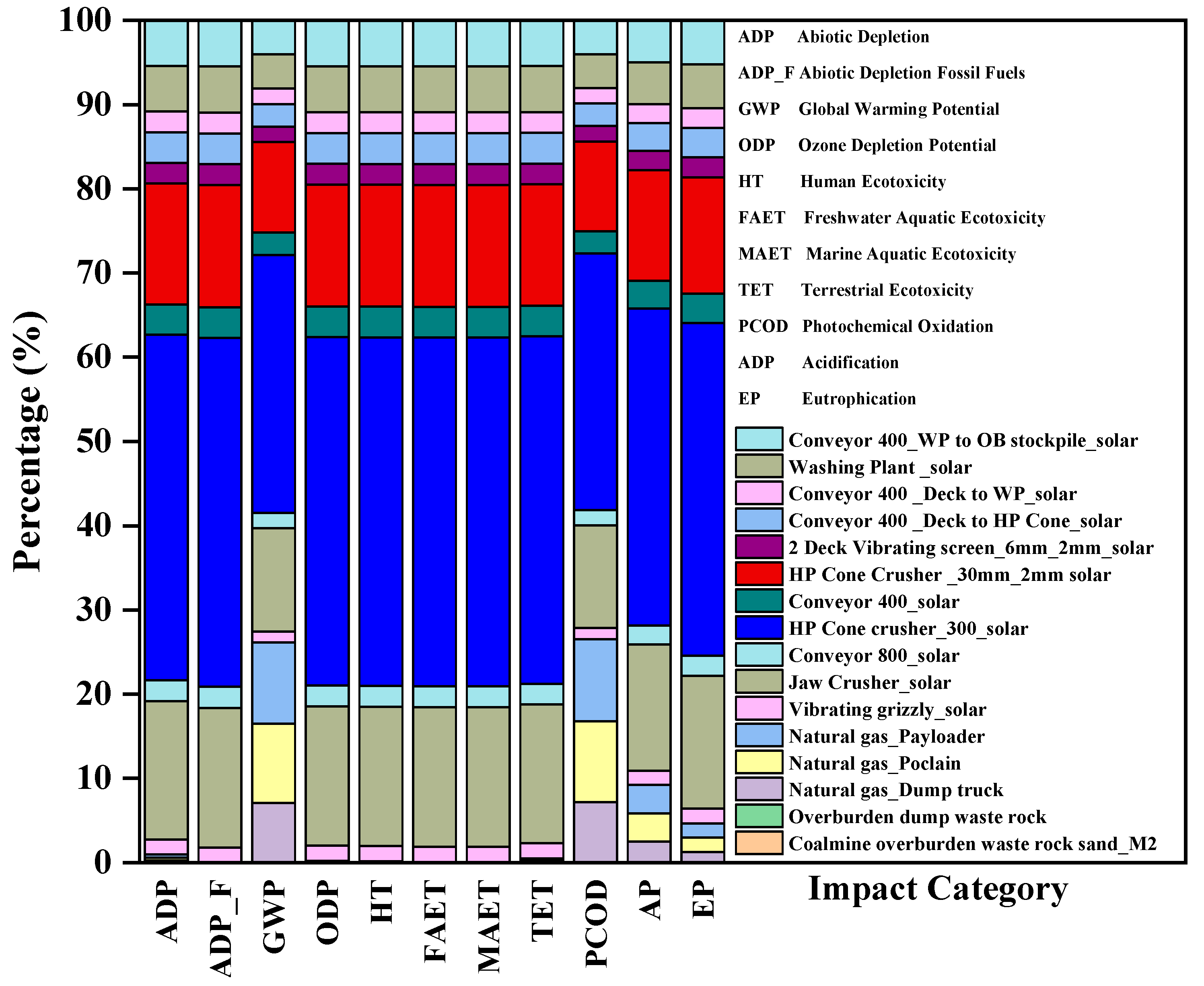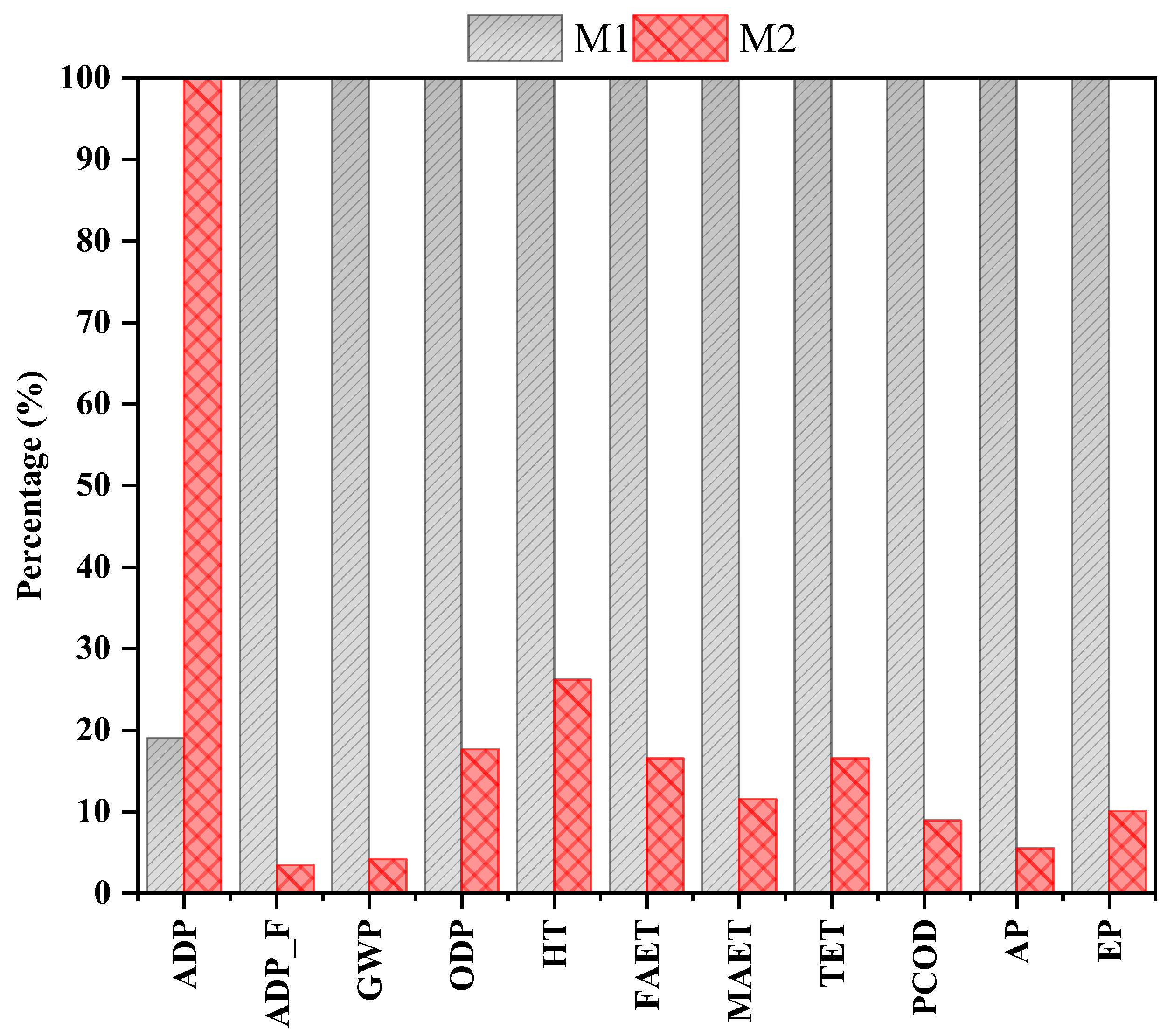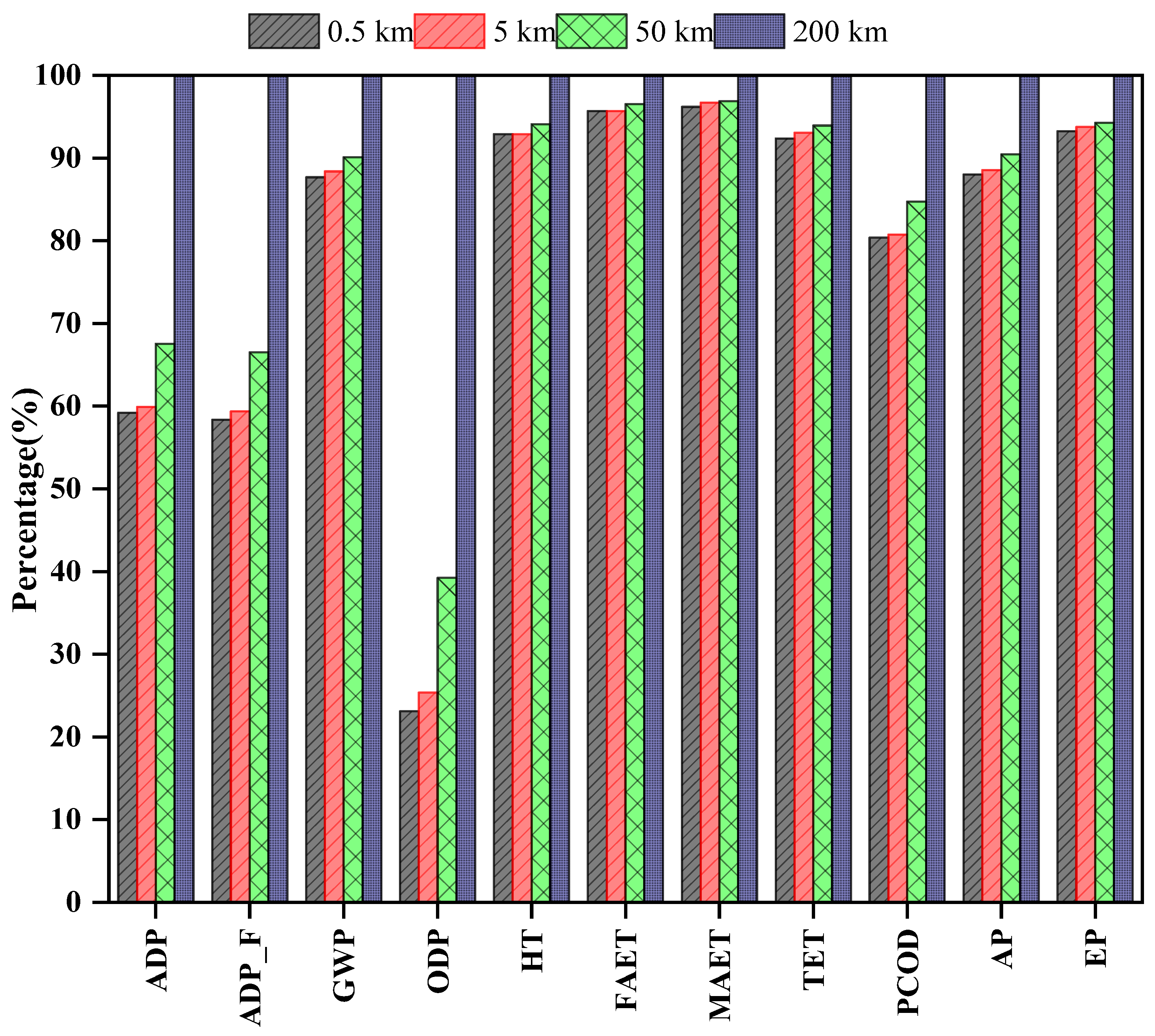Processing Coalmine Overburden Waste Rock as Replacement to Natural Sand: Environmental Sustainability Assessment
Abstract
1. Introduction
2. Life Cycle Assessment (LCA)
2.1. Goal and Scope Definition
2.1.1. System Boundary
2.1.2. Functional Unit
2.2. Life Cycle Inventory (LCI)
2.3. Life Cycle Impact Assessment (LCIA)
3. Results
3.1. Scenario Analysis
3.1.1. Environmental Impacts Due to Processing OBR to OBS Using M1
3.1.2. Environmental Impacts Due to Processing OBR to OBS Using M2
3.1.3. Comparison of M1 and M2
3.1.4. Impact of Change of Source and Quantity of Water
3.1.5. Impact of Change in Location of the Processing Plant
4. Conclusions
- M2 processing of OBR to OBS compared to M1 is more environmentally sustainable in all impact categories other than ADP, which increased by 81%. Natural gas-operated engines is used for loading and hauling. Solar energy is used to operate the processing equipment in place of conventional coal-powered electricity.
- The use of tap water for industrial purposes increases the environmental load due to the processing and transfer of water to the site. This can be improved by recycling water at the site by installing a wastewater treatment plant, but the treatment plant’s life cycle assessment also needs to be studied. A better-optimized use of water is required to control the environmental load due to water consumption.
- The change of location within a 5 km radius of the dump does not significantly contribute to the environmental load. Transportation is the major contributing factor in the processing of OBR to OBS. This can be resolved by developing a mobile crushing unit to produce application-specific gradation wherever possible, whether at the dump or the site of the application of OBS.
- The outcomes show that OBR processing as an alternative to natural sand can be accomplished sustainably, ending several mining-related problem activities. Additionally, this will create employment opportunities for the local population, with a beneficial impact on society.
- Current material specifications and standards do not encompass OB as an aggregate. Hence, the future efforts of researchers and policymakers should be directed towards this issue.
Supplementary Materials
Author Contributions
Funding
Institutional Review Board Statement
Informed Consent Statement
Data Availability Statement
Conflicts of Interest
References
- Torres, A.; Simoni, M.U.; Keiding, J.K.; Müller, D.B.; zu Ermgassen, S.O.; Liu, J.; Jaeger, J.A.; Winter, M.; Lambin, E.F. Sustainability of the Global Sand System in the Anthropocene. One Earth 2021, 4, 639–650. [Google Scholar] [CrossRef]
- Fernandes, J.; Peixoto, M.; Mateus, R.; Gervásio, H. Life Cycle Analysis of Environmental Impacts of Earthen Materials in the Portuguese Context: Rammed Earth and Compressed Earth Blocks. J. Clean. Prod. 2019, 241, 118–286. [Google Scholar] [CrossRef]
- Skarzyńska, K.M. Reuse of Coal Mining Wastes in Civil Engineering—Part 1: Properties of Minestone. Waste Manag. 1995, 15, 3–42. [Google Scholar] [CrossRef]
- Skarzyńska, K.M. Reuse of Coal Mining Wastes in Civil Engineering-Part 2: Utilization of Minestone. Waste Manag. 1995, 15, 83–126. [Google Scholar] [CrossRef]
- Farjana, S.H.; Huda, N.; Mahmud, M.A.P. Impacts of Aluminum Production: A Cradle to Gate Investigation Using Life-Cycle Assessment. Sci. Total Environ. 2019, 663, 958–970. [Google Scholar] [CrossRef]
- Sjunnesson, J. Life Cycle Assessment of Concrete. Master’s Thesis, Lund University, Lund, Sweden, 2005. [Google Scholar]
- Teh, S.H.; Wiedmann, T.; Castel, A.; de Burgh, J. Hybrid Life Cycle Assessment of Greenhouse Gas Emissions from Cement, Concrete and Geopolymer Concrete in Australia. J. Clean. Prod. 2017, 152, 312–320. [Google Scholar] [CrossRef]
- Huntzinger, D.N.; Eatmon, T.D. A Life-Cycle Assessment of Portland Cement Manufacturing: Comparing the Traditional Process with Alternative Technologies. J. Clean. Prod. 2009, 17, 668–675. [Google Scholar] [CrossRef]
- Weil, M.; Dombrowski, K.; Buchwald, A. Life-Cycle Analysis of Geopolymers. In Geopolymers Structures, Processing, Properties and Industrial Applications; Woodhead Publishing: Cambridge, UK, 2009; pp. 194–210. [Google Scholar] [CrossRef]
- Salas, D.A.; Ramirez, A.D.; Ulloa, N.; Baykara, H.; Boero, A.J. Life Cycle Assessment of Geopolymer Concrete. sConstr. Build. Mater. 2018, 190, 170–177. [Google Scholar] [CrossRef]
- Korre, A.; Durucan, S. Life Cycle Assessment of Aggregates. In EVA025—Final Report: Aggregates Industry Life Cycle Assessment Model: Modelling Tools and Case Studies; Waste and Resources Action Programme: Oxon, UK, 2009; pp. 1–41. [Google Scholar]
- Shi, X.; Mukhopadhyay, A.; Zollinger, D. Sustainability Assessment for Portland Cement Concrete Pavement Containing Reclaimed Asphalt Pavement Aggregates. J. Clean. Prod. 2018, 192, 569–581. [Google Scholar] [CrossRef]
- Park, W.J.; Kim, T.; Roh, S.; Kim, R. Analysis of Life Cycle Environmental Impact of Recycled Aggregate. Appl. Sci. 2019, 9, 1021. [Google Scholar] [CrossRef]
- Djadouni, H.; Trouzine, H.; Gomes Correia, A.; Miranda, T.F.d.S. Life Cycle Assessment of Retaining Wall Backfilled with Shredded Tires. Int. J. Life Cycle Assess. 2019, 24, 581–589. [Google Scholar] [CrossRef]
- Cuenca-Moyano, G.M.; Martín-Morales, M.; Bonoli, A.; Valverde-Palacios, I. Environmental Assessment of Masonry Mortars Made with Natural and Recycled Aggregates. Int. J. Life Cycle Assess. 2019, 24, 191–210. [Google Scholar] [CrossRef]
- Suresh, D.; Chawla, S. Comparative Life Cycle Assessment of Railway Subballast Layer with Natural and Coal Overburden Aggregates in India. Int. J. Life Cycle Assess. 2022, 27, 704–718. [Google Scholar] [CrossRef]
- ISO 14040; Environmental Management-Life Cycle Assessment, Principles and Guidelines. International Organization for Standardization: Geneva, Switzerland, 2006.
- ISO 14044; Environmental Management-Life Cycle Assessment, Life Cycle Impact Assessment. International Organization for Standardization: Geneva, Switzerland, 2006.
- JXCE JXCE Mining Equipment. Available online: https://www.jxscmachine.com/product/ (accessed on 17 October 2022).
- Rebitzer, G.; Ekvall, T.; Frischknecht, R.; Hunkeler, D.; Norris, G.; Rydberg, T.; Suh, S.; Weidema, B.P.; Pennington, D.W. Life Cycle Assessment Part 1: Framework, Goal and Scope Definition, Inventory Analysis, and Applications. Environ. Int. 2004, 30, 701–720. [Google Scholar] [CrossRef] [PubMed]
- SimaPro Database Manual Methods Library, Database & Support Team at PRé Sustainabilit. 2022, pp. 1–56. Available online: https://simapro.com/wp-content/uploads/2022/07/DatabaseManualMethods.pdf (accessed on 27 September 2022).
- Gediga, J.; Morfino, A.; Finkbeiner, M.; Schulz, M.; Harlow, K. Life Cycle Assessment of Zircon Sand. Int. J. Life Cycle Assess. 2019, 24, 1976–1984. [Google Scholar] [CrossRef]
- Grbeš, A. A Life Cycle Assessment of Silica Sand: Comparing the Beneficiation Processes. Sustainability 2016, 8, 11. [Google Scholar] [CrossRef]







| Impact Category | ADP | ADP_F | GWP | ODP | HT | FAET | MAET | TET | PCOD | AP | EP |
|---|---|---|---|---|---|---|---|---|---|---|---|
| Unit | kg Sb eq | MJ | kg CO2 eq | kg CFC-11 eq | kg 1,4-DB eq | kg 1,4-DB eq | kg 1,4-DB eq | kg 1,4-DB eq | kg C2H4 eq | kg SO2 eq | kg PO4---eq |
| Total | 8.31 × 10−7 | 8.61 × 10+01 | 5.81 | 8.58 × 10−8 | 1.48 | 1.32 | 8.19 × 10+03 | 3.74 × 10−3 | 1.48 × 10−3 | 4.00 × 10−2 | 9.37 × 10−3 |
| Coalmine overburden waste rock sand_M1 | 0 | 0 | 0 | 0 | 6.83 × 10−3 | 0 | 0 | 0 | 0 | 0 | 0 |
| Overburden dump waste rock | 0 | 0 | 0 | 0 | 0 | 0 | 0 | 0 | 0 | 0 | 0 |
| Diesel, low sulfur {RoW}|market for Dump truck _to site|Alloc Def, U | 1.97 × 10−8 | 2.11 | 2.59 × 10−2 | 9.94 × 10−9 | 3.50 × 10−3 | 1.60 × 10−3 | 7.59 | 9.16 × 10−6 | 1.20 × 10−5 | 1.74 × 10−4 | 1.92 × 10−5 |
| Diesel {RoW}|market for Poclain|Alloc Def, U | 1.64 × 10−8 | 2.77 | 3.16 × 10−2 | 1.31 × 10−8 | 3.92 × 10−3 | 1.61 × 10−3 | 7.90 | 9.73 × 10−6 | 1.50 × 10−5 | 2.09 × 10−4 | 2.16 × 10−5 |
| Diesel {RoW}|market for Payloader|Alloc Def, U | 1.67 × 10−8 | 2.82 | 3.21 × 10−2 | 1.33 × 10−8 | 3.98 × 10−3 | 1.64 × 10−3 | 8.03 | 9.88 × 10−6 | 1.52 × 10−5 | 2.12 × 10−4 | 2.19 × 10−5 |
| vibrating grizzly feeder (electricity) | 1.42 × 10−8 | 1.43 | 1.04 × 10−1 | 9.01 × 10−10 | 2.67 × 10−2 | 2.40 × 10−2 | 1.49 × 10+02 | 6.76 × 10−5 | 2.63 × 10−5 | 7.18 × 10−4 | 1.70 × 10−4 |
| Jaw Crusher (electricity) | 1.29 × 10−7 | 1.30 × 10+01 | 9.48 × 10−1 | 8.19 × 10−9 | 2.43 × 10−1 | 2.18 × 10−1 | 1.35 × 10+03 | 6.14 × 10−4 | 2.39 × 10−4 | 6.53 × 10−3 | 1.54 × 10−3 |
| Conveyor 800 mm (electricity) | 1.93 × 10−8 | 1.95 | 1.42 × 10−1 | 1.23 × 10−9 | 3.64 × 10−2 | 3.27 × 10−2 | 2.03 × 10+02 | 9.21 × 10−5 | 3.58 × 10−5 | 9.79 × 10−4 | 2.31 × 10−4 |
| HP Cone Crusher 300 (electricity) | 3.22 × 10−7 | 3.25 × 10+01 | 2.37 | 2.05 × 10−8 | 6.07 × 10−1 | 5.45 × 10−1 | 3.38 × 10+03 | 1.54 × 10−3 | 5.97 × 10−4 | 1.63 × 10−2 | 3.85 × 10−3 |
| Conveyor 400 mm (electricity) | 2.84 × 10−8 | 2.86 | 2.09 × 10−1 | 1.80 × 10−9 | 5.34 × 10−2 | 4.80 × 10−2 | 2.98 × 10+02 | 1.35 × 10−4 | 5.25 × 10−5 | 1.44 × 10−3 | 3.39 × 10−4 |
| HP Cone Crusher 300_30_2 (electricity) | 1.13 × 10−7 | 1.14 × 10+01 | 8.30 × 10−1 | 7.17 × 10−9 | 2.12 × 10−1 | 1.91 × 10−1 | 1.18 × 10+03 | 5.37 × 10−4 | 2.09 × 10−4 | 5.71 × 10−3 | 1.35 × 10−3 |
| 2 Deck Vibrating Screen (electricity) | 1.93 × 10−8 | 1.95 | 1.42 × 10−1 | 1.23 × 10−9 | 3.64 × 10−2 | 3.27 × 10−2 | 2.03 × 10+02 | 9.21 × 10−5 | 3.58 × 10−5 | 9.79 × 10−4 | 2.31 × 10−4 |
| Conveyor 400 mm deck to cone HP 300 (electricity) | 2.84 × 10−8 | 2.86 | 2.09 × 10−1 | 1.80 × 10−9 | 5.34 × 10−2 | 4.80 × 10−2 | 2.98 × 10+02 | 1.35 × 10−4 | 5.25 × 10−5 | 1.44 × 10−3 | 3.39 × 10−4 |
| Conveyor 400 mm Deck to Washing Plant(electricity) | 1.93 × 10−8 | 1.95 | 1.42 × 10−1 | 1.23 × 10−9 | 3.64 × 10−2 | 3.27 × 10−2 | 2.03 × 10+02 | 9.21 × 10−5 | 3.58 × 10−5 | 9.79 × 10−4 | 2.31 × 10−4 |
| Washing Plant x 3U 40TPH(electricity) | 4.25 × 10−8 | 4.29 | 3.13 × 10−1 | 2.70 × 10−9 | 8.01 × 10−2 | 7.20 × 10−2 | 4.47 × 10+02 | 2.03 × 10−4 | 7.88 × 10−5 | 2.15 × 10−3 | 5.09 × 10−4 |
| Conveyor 400 mm x 3_WP_OBSTOCK (electricity) | 4.25 × 10−8 | 4.29 | 3.13 × 10−1 | 2.70 × 10−9 | 8.01 × 10−2 | 7.20 × 10−2 | 4.47 × 10+02 | 2.03 × 10−4 | 7.88 × 10−5 | 2.15 × 10−3 | 5.09 × 10−4 |
| Wastewater treatment, other emissions | 0 | 0 | 0 | 0 | 0 | 0 | 0 | 0 | 0 | 0 | 0 |
| Impact Category | ADP | ADP_F | GWP | ODP | HT | FAET | MAET | TET | PCOD | AP | EP |
|---|---|---|---|---|---|---|---|---|---|---|---|
| Unit | kg Sb eq | MJ | kg CO2 eq | kg CFC-11 eq | kg 1,4-DB eq | kg 1,4-DB eq | kg 1,4-DB eq | kg 1,4-DB eq | kg C2H4 eq | kg SO2 eq | kg PO4---eq |
| Total | 4.4 × 10−6 | 2.6 | 2.6 × 10−1 | 1.4 × 10−8 | 4.0 × 10−1 | 2.2 × 10−1 | 8.9 × 10+02 | 6.1 × 10−4 | 1.2 × 10−4 | 2.3 × 10−3 | 9.1 × 10−4 |
| Coalmine overburden waste rock sand_M2 | 0 | 0 | 0 | 0 | 0 | 0 | 0 | 0 | 0 | 0 | 0 |
| Overburden dump waste rock | 0 | 0 | 0 | 0 | 0 | 0 | 0 | 0 | 0 | 0 | 0 |
| Dump truck Natural gas_ Dump_to_plant | 1.1 × 10−8 | 0.0 | 1.8 × 10−2 | 7.8 × 10−12 | 1.6 × 10−4 | 3.2 × 10−5 | 1.7 × 10−1 | 7.8 × 10−7 | 8.8 × 10−6 | 5.9 × 10−5 | 1.2 × 10−5 |
| Poclain Natural gas_ Loading_dumptruck | 1.5 × 10−8 | 0.0 | 2.5 × 10−2 | 1.0 × 10−11 | 2.1 × 10−4 | 4.3 × 10−5 | 2.3 × 10−1 | 1.0 × 10−6 | 1.2 × 10−5 | 7.8 × 10−5 | 1.5 × 10−5 |
| Payloader Natural gas_ Loading_sand_truck | 1.5 × 10−8 | 0.0 | 2.5 × 10−2 | 1.1 × 10−11 | 2.2 × 10−4 | 4.4 × 10−5 | 2.3 × 10−1 | 1.1 × 10−6 | 1.2 × 10−5 | 7.9 × 10−5 | 1.6 × 10−5 |
| Vibrating grizzly solar energy | 7.9 × 10−8 | 4.7 × 10−2 | 3.5 × 10−3 | 2.5 × 10−10 | 7.2 × 10−3 | 4.0 × 10−3 | 1.6 × 10+01 | 1.1 × 10−5 | 1.6 × 10−6 | 3.9 × 10−5 | 1.6 × 10−5 |
| Jaw crusher solar energy | 7.2 × 10−7 | 4.3 × 10−1 | 3.2 × 10−2 | 2.3 × 10−9 | 6.5 × 10−2 | 3.6 × 10−2 | 1.5 × 10+02 | 1.0 × 10−4 | 1.5 × 10−5 | 3.5 × 10−4 | 1.4 × 10−4 |
| Conveyor_800_ _solar energy | 1.1 × 10−7 | 6.5 × 10−2 | 4.8 × 10−3 | 3.4 × 10−10 | 9.8 × 10−3 | 5.4 × 10−3 | 2.2 × 10+01 | 1.5 × 10−5 | 2.2 × 10−6 | 5.3 × 10−5 | 2.1 × 10−5 |
| HP_Cone_crusher_ 300_solar energy | 1.8 × 10−6 | 1.1 | 8.0 × 10−2 | 5.6 × 10−9 | 1.6 × 10−1 | 9.1 × 10−2 | 3.7 × 10+02 | 2.5 × 10−4 | 3.7 × 10−5 | 8.8 × 10−4 | 3.6 × 10−4 |
| Conveyor_400__ solar energy | 1.6 × 10−7 | 9.5 × 10−2 | 7.0 × 10−3 | 5.0 × 10−10 | 1.4 × 10−2 | 8.0 × 10−3 | 3.2 × 10+01 | 2.2 × 10−5 | 3.3 × 10−6 | 7.7 × 10−5 | 3.2 × 10−5 |
| HP_Cone_crusher_ 30mm_2mm_solar energy | 6.3 × 10−7 | 3.8 × 10−1 | 2.8 × 10−2 | 2.0 × 10−9 | 5.7 × 10−2 | 3.2 × 10−2 | 1.3 × 10+02 | 8.8 × 10−5 | 1.3 × 10−5 | 3.1 × 10−4 | 1.3 × 10−4 |
| 2_Deck_vibrating Screen _6mm_2mm__solar energy | 1.1 × 10−7 | 6.5 × 10−2 | 4.8 × 10−3 | 3.4 × 10−10 | 9.8 × 10−3 | 5.4 × 10−3 | 2.2 × 10+01 | 1.5 × 10−5 | 2.2 × 10−6 | 5.3 × 10−5 | 2.1 × 10−5 |
| Conveyor_400_Deck_ HP_Cone_solar energy | 1.6 × 10−7 | 9.5 × 10−2 | 7.0 × 10−3 | 5.0 × 10−10 | 1.4 × 10−2 | 8.0 × 10−3 | 3.2 × 10+01 | 2.2 × 10−5 | 3.3 × 10−6 | 7.7 × 10−5 | 3.2 × 10−5 |
| Conveyor_400_Deck_to_ Washing_plant__solar energy | 1.1 × 10−7 | 6.5 × 10−2 | 4.8 × 10−3 | 3.4 × 10−10 | 9.8 × 10−3 | 5.4 × 10−3 | 2.2 × 10+01 | 1.5 × 10−5 | 2.2 × 10−6 | 5.3 × 10−5 | 2.1 × 10−5 |
| Washing plant_ _solar energy | 2.4 × 10−7 | 1.4 × 10−1 | 1.0 × 10−2 | 7.5 × 10−10 | 2.2 × 10−2 | 1.2 × 10−2 | 4.9 × 10+01 | 3.3 × 10−5 | 4.9 × 10−6 | 1.2 × 10−4 | 4.7 × 10−5 |
| Conveyor_400_washingplan t_to_OBstockpile_solar energy | 2.4 × 10−7 | 1.4 × 10−1 | 1.0 × 10−2 | 7.5 × 10−10 | 2.2 × 10−2 | 1.2 × 10−2 | 4.9 × 10+01 | 3.3 × 10−5 | 4.9 × 10−6 | 1.2 × 10−4 | 4.7 × 10−5 |
| Impact Category | ADP | ADP_F | GWP | ODP | HT | FAET | MAET | TET | PCOD | AP | EP |
|---|---|---|---|---|---|---|---|---|---|---|---|
| Unit | kg Sb eq | MJ | kg CO2 eq | kg CFC-11 eq | kg 1,4-DB eq | kg 1,4-DB eq | kg 1,4-DB eq | kg 1,4-DB eq | kg C2H4 eq | kg SO2 eq | kg PO4---eq |
| Coalmine overburden waste rock sand_M1 | 8.18 × 10−7 | 8.47 × 10+01 | 5.80 | 7.92 × 10−8 | 1.48 | 1.32 | 8.19 × 10+03 | 3.73 × 10−3 | 1.48 × 10−3 | 3.99 × 10−2 | 9.36 × 10−3 |
| Coalmine overburden waste rock sand_M2 | 4.35 × 10−6 | 2.60 | 2.48 × 10−1 | 1.36 × 10−8 | 3.95 × 10−1 | 2.19 × 10−1 | 8.90 × 10+02 | 6.08 × 10−4 | 1.17 × 10−4 | 2.30 × 10−3 | 8.99 × 10−4 |
| Impact Category | ADP | ADP_F | GWP | ODP | HT | FAET | MAET | TET | PCOD | AP | EP |
|---|---|---|---|---|---|---|---|---|---|---|---|
| Unit | kg Sb eq | MJ | kg CO2 eq | kg CFC-11 eq | kg 1,4-DB eq | kg 1,4-DB eq | kg 1,4-DB eq | kg 1,4-DB eq | kg C2H4 eq | kg SO2 eq | kg PO4---eq |
| Coalmine overburden waste rock sand_M1_2L | 8.31 × 10−7 | 8.61 × 10+01 | 5.81 | 8.58 × 10−8 | 1.48 | 1.32 | 8.19 × 10+03 | 3.74 × 10−3 | 1.48 × 10−3 | 4.00 × 10−2 | 9.37 × 10−3 |
| Coalmine overburden waste rock sand_M1_2L_lake | 8.31 × 10−7 | 8.61 × 10+01 | 5.81 | 8.58 × 10−8 | 1.48 | 1.32 | 8.19 × 10+03 | 3.74 × 10−3 | 1.48 × 10−3 | 4.00 × 10−2 | 9.37 × 10−3 |
| Coalmine overburden waste rock sand_M1_2L_watertransformation | 2.79 × 10−6 | 9.82 × 10+01 | 6.76 | 1.17 × 10−7 | 1.78 | 1.71 | 9.32 × 10+03 | 4.62 × 10−3 | 1.75 × 10−3 | 4.63 × 10−2 | 1.08 × 10−2 |
| Coalmine overburden waste rock sand_M1_5L_watertransformation | 5.73 × 10−6 | 1.16 × 10+02 | 8.18 | 1.64 × 10−7 | 2.22 | 2.28 | 1.10 × 10+04 | 5.95 × 10−3 | 2.15 × 10−3 | 5.57 × 10−2 | 1.28 × 10−2 |
| Coalmine overburden waste rock sand_M1_10L_watertransformation | 1.06 × 10−5 | 1.47 × 10+02 | 1.06 × 10+01 | 2.41 × 10−7 | 2.95 | 3.25 | 1.38 × 10+04 | 8.16 × 10−3 | 2.81 × 10−3 | 7.15 × 10−2 | 1.63 × 10−2 |
| Impact category | ADP | ADP_F | GWP | ODP | HT | FAET | MAET | TET | PCOD | AP | EP |
|---|---|---|---|---|---|---|---|---|---|---|---|
| Unit | kg Sb eq | MJ | kg CO2 eq | kg CFC-11 eq | kg 1,4-DB eq | kg 1,4-DB eq | kg 1,4-DB eq | kg 1,4-DB eq | kg C2H4 eq | kg SO2 eq | kg PO4--- eq |
| Coalmine overburden waste rock sand_M1_2L_0.5km | 8.31 × 10−7 | 8.61 × 10+01 | 5.81 | 8.58 × 10−8 | 1.48 | 1.32 | 8.19 × 10+03 | 3.74 × 10−3 | 1.48 × 10−3 | 4.00 × 10−2 | 9.37 × 10−3 |
| Coalmine overburden waste rock sand_M1_2L_5km | 8.46 × 10−7 | 8.77 × 10+01 | 5.83 | 9.33 × 10−8 | 1.49 | 1.32 | 8.20 × 10+03 | 3.74 × 10−3 | 1.49 × 10−3 | 4.01 × 10−2 | 9.38 × 10−3 |
| Coalmine overburden waste rock sand_M1_2L_50km | 9.49 × 10−7 | 9.88 × 10+01 | 5.97 | 1.45 × 10−7 | 1.50 | 1.33 | 8.24 × 10+03 | 3.79 × 10−3 | 1.56 × 10−3 | 4.10 × 10−2 | 9.48 × 10−3 |
| Coalmine overburden waste rock sand_M1_2L_200km | 1.39 × 10−6 | 1.46 × 10+02 | 6.55 | 3.70 × 10−7 | 1.58 | 1.37 | 8.41 × 10+03 | 4.00 × 10−3 | 1.83 × 10−3 | 4.50 × 10−2 | 9.92 × 10−3 |
Publisher’s Note: MDPI stays neutral with regard to jurisdictional claims in published maps and institutional affiliations. |
© 2022 by the authors. Licensee MDPI, Basel, Switzerland. This article is an open access article distributed under the terms and conditions of the Creative Commons Attribution (CC BY) license (https://creativecommons.org/licenses/by/4.0/).
Share and Cite
Mishra, A.; Das, S.K.; Reddy, K.R. Processing Coalmine Overburden Waste Rock as Replacement to Natural Sand: Environmental Sustainability Assessment. Sustainability 2022, 14, 14853. https://doi.org/10.3390/su142214853
Mishra A, Das SK, Reddy KR. Processing Coalmine Overburden Waste Rock as Replacement to Natural Sand: Environmental Sustainability Assessment. Sustainability. 2022; 14(22):14853. https://doi.org/10.3390/su142214853
Chicago/Turabian StyleMishra, Anshumali, Sarat Kumar Das, and Krishna R. Reddy. 2022. "Processing Coalmine Overburden Waste Rock as Replacement to Natural Sand: Environmental Sustainability Assessment" Sustainability 14, no. 22: 14853. https://doi.org/10.3390/su142214853
APA StyleMishra, A., Das, S. K., & Reddy, K. R. (2022). Processing Coalmine Overburden Waste Rock as Replacement to Natural Sand: Environmental Sustainability Assessment. Sustainability, 14(22), 14853. https://doi.org/10.3390/su142214853








